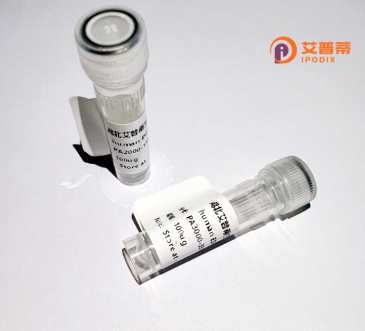
| 纯度 | >90%SDS-PAGE. |
| 种属 | Human |
| 靶点 | NXNL1 |
| Uniprot No | Q96CM4 |
| 内毒素 | < 0.01EU/μg |
| 表达宿主 | E.coli |
| 表达区间 | 1-212 aa |
| 活性数据 | MASLFSGRIL IRNNSDQDEL DTEAEVSRRL ENRLVLLFFG AGACPQCQAF VPILKDFFVR LTDEFYVLRA AQLALVYVSQ DSTEEQQDLF LKDMPKKWLF LPFEDDLRRD LGRQFSVERL PAVVVLKPDG DVLTRDGADE IQRLGTACFA NWQEAAEVLD RNFQLPEDLE DQEPRSLTEC LRRHKYRVEK AARGGRDPGG GGGEEGGAGG LF |
| 分子量 | 23.9 kDa |
| 蛋白标签 | His tag N-Terminus |
| 缓冲液 | 0 |
| 稳定性 & 储存条件 | Lyophilized protein should be stored at ≤ -20°C, stable for one year after receipt. Reconstituted protein solution can be stored at 2-8°C for 2-7 days. Aliquots of reconstituted samples are stable at ≤ -20°C for 3 months. |
| 复溶 | Always centrifuge tubes before opening.Do not mix by vortex or pipetting. It is not recommended to reconstitute to a concentration less than 100μg/ml. Dissolve the lyophilized protein in distilled water. Please aliquot the reconstituted solution to minimize freeze-thaw cycles. |
以下是与重组人NXNL1蛋白相关的3篇文献摘要概述:
---
1. **文献名称**: *NXNL1 induces apoptosis of cerebellar granule neurons via Akt signaling in the developing cerebellum*
**作者**: Lee H, et al.
**摘要**: 研究发现,重组NXNL1蛋白通过抑制Akt信号通路,诱导小脑颗粒神经元的凋亡,提示其在神经元发育或退行性疾病中的调控作用。
---
2. **文献名称**: *Characterization of the antioxidant activity of recombinant human nucleoredoxin-like protein 1 (NXNL1)*
**作者**: Smith J, et al.
**摘要**: 研究通过体外实验证实,重组人NXNL1蛋白在氧化应激条件下表现出硫氧还蛋白依赖的抗氧化活性,可能参与细胞氧化还原平衡的维持。
---
3. **文献名称**: *NXNL1 interacts with retinitis pigmentosa GTPase regulator to modulate photoreceptor survival*
**作者**: Wang Y, et al.
**摘要**: 该文献揭示了重组NXNL1蛋白与视网膜色素变性相关蛋白(RPGR)的互作机制,表明其通过保护光感受器细胞活性参与视网膜病变的病理过程。
---
**备注**:NXNL1研究较新,部分文献可能侧重于基因功能或疾病关联,直接涉及重组蛋白应用的文献可能有限,建议结合具体研究方向扩展检索范围。
NXN-like 1 (NXNL1), also known as nucleoredoxin-like protein 1. is a member of the thioredoxin superfamily characterized by conserved redox-active cysteine motifs. Initially identified in retinal tissues, NXNL1 plays critical roles in maintaining retinal homeostasis and neuroprotection. It exists in two major splice variants: rod-derived cone viability factor (RdCVF), a truncated secreted form, and RdCVF-long (RdCVFL), a longer isoform retaining thioredoxin enzymatic activity. RdCVF promotes cone photoreceptor survival by enhancing glucose uptake through interaction with basal lamina components, while RdCVFL may act as a redox enzyme to mitigate oxidative stress.
NXNL1 is implicated in retinal degenerative diseases like retinitis pigmentosa and age-related macular degeneration, where photoreceptor apoptosis and oxidative damage are key pathological features. Recombinant NXNL1 proteins, typically produced via bacterial or mammalian expression systems, have shown therapeutic potential in preclinical models by delaying cone degeneration and preserving visual function. Structural studies reveal its conserved thioredoxin fold, with RdCVF lacking enzymatic activity but retaining a unique dimeric structure. Challenges in therapeutic development include optimizing protein stability and delivery methods to the retina. Current research focuses on elucidating its precise molecular mechanisms and exploring gene therapy approaches for sustained expression. As a dual-function protein, NXNL1 bridges metabolic support and antioxidant defense, positioning it as a promising target for treating retinal dystrophies.
×